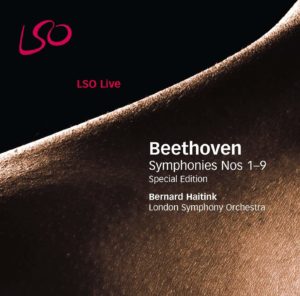 In this Beethoven project, I first encountered Dutch conductor Bernard Haitink (1929- ) on Day 8, and then again on Day 26.
In this Beethoven project, I first encountered Dutch conductor Bernard Haitink (1929- ) on Day 8, and then again on Day 26.
On those two days – as it will be for the next six times I hear Haitink conduct – the orchestra is the London Symphony Orchestra.
The back of the liner notes tells us,
LSO Live captures the exceptional performances from the finest musicians using the latest high-density recording technology. The result? Sensational sound quality and definitive interpretations combined with the energy and emotion that you can only experience in the concert hall. LSO Live lets everyone, everywhere, feel the excitement in the world’s greatest music.
Yes, yes. But will Haitink, the LSO, and superior recording techniques result in a symphony worth hearing today?
From the liner notes on Beethoven’s Third, written by Lindsey Kemp,
Only a year separates the completion of Beethoven’s Second Symphony from that of his Third, yet in that time the composer made an enormous leap forward that left his contemporaries gasping in his wake. It was not just that the ‘Eroica’ (‘Heroic’) expanded the physical size of the symphony to hitherto unknown dimensions; it also imbued the genre with a new and gigantic message, turning it into an artistic and philosophical statement that transcended any of its previously accepted functions. For here Beethoven used the symphony to express nothing less than his abiding faith in mankind’s capacity for greatness.
Greatness? Really? Is that what I’m in store for?
I’ll soon find out.
 Beethoven wrote his symphonies in four parts (except for the Sixth, which is in five). The time breakdown of this particular one (Symphony No. 3 in E flat Major), from this particular conductor (Haitink, at age 77) and this particular orchestra (London Symphony Orchestra), at this particular time in history (November 21 & 22, 2005) on this particular record label (LSO Live) is as follows:
Beethoven wrote his symphonies in four parts (except for the Sixth, which is in five). The time breakdown of this particular one (Symphony No. 3 in E flat Major), from this particular conductor (Haitink, at age 77) and this particular orchestra (London Symphony Orchestra), at this particular time in history (November 21 & 22, 2005) on this particular record label (LSO Live) is as follows:
I. Allegro con brio………………………………………………………………………17:49
II. Marcia funebre: Adagio assai……………………………………………….14:22
III. Scherzo: Allegro vivace – Trio…………………………………………………5:54
IV. Finale: Allegro molto – Poco andante – Presto…………………..11:06
Total running time: 48:31
My Rating:
Recording quality: 5 (SACD multi-channel recording, rich, lush, and crystal clear)
Overall musicianship: 5 (flawless)
CD liner notes: 5 (big booklet with lots of pertinent information and essays)
How does this make me feel: 5
They weren’t kidding on the back of the liner notes. The recording today is in glorious 5.0 Multichannel, which gives it an energy usually not found in many other recordings. And it does have a kind of in-the-concert-hall feel to it.
On top of that, this is a brisk (48 minutes) performance that doesn’t dally too long, which is always my fear with each conductor I encounter in succession. Will he play with the tempi and stretch it out? Will he ignore the tempi and play it so fast that it feels rushed? I never know until I pop in my ear buds.
In general I’m not a big fan of second movements. Adagios usually aren’t my cup o’ Joe. They can bog down a bit, meander too much. This one is no excpetion, which is why the ever-so-much-fun Scherzo (Movement III) provides a much-needed kick start that leads swiftly into the wonderfully energetic and triumphant Finale.
Another “Huzzah!” for Bernard Haitink, the LSO, and Beethoven.
I recommend this performance.
